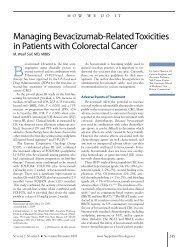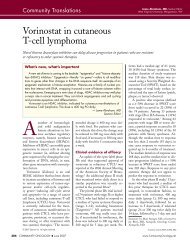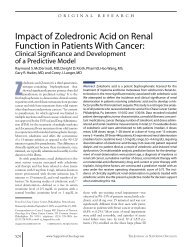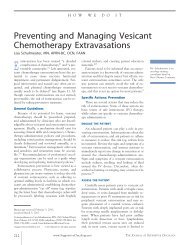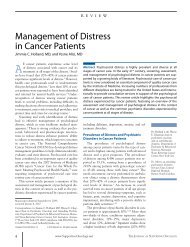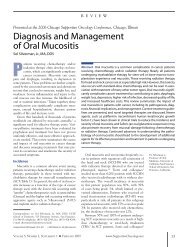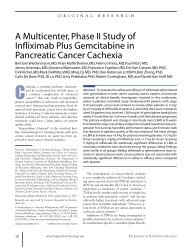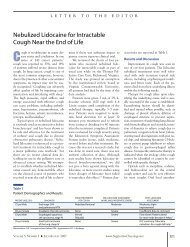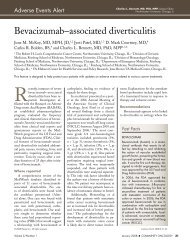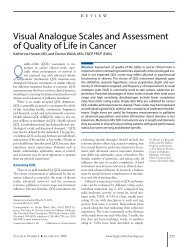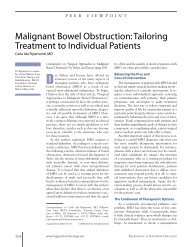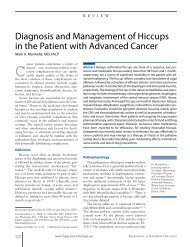Evaluating the “Good Death” Concept from Iranian Bereaved Family
Evaluating the “Good Death” Concept from Iranian Bereaved Family
Evaluating the “Good Death” Concept from Iranian Bereaved Family
Create successful ePaper yourself
Turn your PDF publications into a flip-book with our unique Google optimized e-Paper software.
O R I G I N A L R E S E A R C H<br />
Estimating Minimally Important<br />
Differences for <strong>the</strong> Worst Pain Rating of<br />
<strong>the</strong> Brief Pain Inventory–Short Form<br />
Susan D. Mathias, MPH, Ross D. Crosby, PhD, Yi Qian, PhD, Qi Jiang, PhD, Roger Dansey, MD, and<br />
Karen Chung, PharmD, MS<br />
Certain outcomes, such as pain, are only<br />
known to patients and <strong>the</strong>refore are best<br />
reported through a patient-reported outcome<br />
(PRO) measure. To be clinically useful, a<br />
PRO measure must be valid, reliable, and responsive<br />
to change. In addition, interpretation of data<br />
<strong>from</strong> PRO measures is aided by estimation of <strong>the</strong><br />
minimally important difference (MID). The<br />
MID is <strong>the</strong> smallest difference in a PRO measure<br />
that a patient would consider beneficial or detrimental.<br />
Although <strong>the</strong> MID may not affect <strong>the</strong><br />
patient’s clinical treatment or care, patients are<br />
<strong>the</strong> primary stakeholders in <strong>the</strong> evaluation of<br />
PROs, and patient-perceived differences are particularly<br />
relevant in advanced stages of disease<br />
where palliation may be <strong>the</strong> focus of treatment. 1<br />
The MID may be estimated through distribution-based<br />
methods and/or anchor-based methods.<br />
Distribution-based methods are based on <strong>the</strong><br />
distribution of <strong>the</strong> data. Examples of distributionbased<br />
methods include effect size measures, <strong>the</strong><br />
standard error of measurement (SEM), one-half<br />
times <strong>the</strong> standard deviation, and <strong>the</strong> responsiveness<br />
index. 2,3 Anchor-based methods are based<br />
on <strong>the</strong> association between <strong>the</strong> PRO measure<br />
and an interpretable external measure, such as a<br />
global rating of change or a response to treatment.<br />
These methods may result in somewhat<br />
From Health Outcomes Solutions, Winter Park, Florida; Biomedical<br />
Statistics and Methodology, Neuropsychiatric Research<br />
Institute, Fargo, North Dakota; Global Biostatistics,<br />
Global Development, and Global Health Economics, Amgen,<br />
Inc., Thousand Oaks, California.<br />
Manuscript received June 25, 2010; Accepted December 3,<br />
2010.<br />
Correspondence to: Susan D. Mathias, Health Outcomes<br />
Solutions, PO Box 2343, Winter Park, FL 32790; telephone:<br />
(407) 643-9016; fax: (866) 384-0194; e-mail: smathias@<br />
healthoutcomessolutions.com<br />
J Support Oncol 2011;9:72–78 © 2011 Elsevier Inc. All rights reserved.<br />
doi:10.1016/j.suponc.2010.12.004<br />
Abstract The Brief Pain Inventory–Short Form (BPI-SF) is widely used for<br />
assessing pain in clinical and research studies. The worst pain rating is often<br />
<strong>the</strong> primary outcome of interest; yet, no published data are available on its<br />
minimally important difference (MID). Breast cancer patients with bone<br />
metastases enrolled in a randomized, double-blind, phase III study comparing<br />
denosumab with zoledronic acid for preventing skeletal related<br />
events and completed <strong>the</strong> BPI-SF, FACT-B, and EQ-5D at baseline, week 5,<br />
and monthly through <strong>the</strong> end of <strong>the</strong> study. Anchor- and distribution-based<br />
MID estimates were computed. Data <strong>from</strong> 1,564 patients were available.<br />
Spearman correlation coefficients for anchors ranged <strong>from</strong> 0.33–0.65.<br />
Mean change scores for worst pain ratings corresponding to one-category<br />
improvement in each anchor were 0.26–1.04 for BPI-SF current pain, �1.40<br />
to �2.42 for EQ-5D Index score, 1.71–1.98 for EQ-5D Pain item, �2.22 to<br />
�0.51 for FACT-B TOI, �1.61 to �0.16 for FACT-G Physical, and �1.31 to<br />
�0.12 for FACT-G total. Distribution-based results were 1 SEM � 1.6, 0.5<br />
effect size � 1.4, and Guyatt’s statistic � 1.4. Combining anchor- and<br />
distribution-based results yielded a two-point MID estimate. An MID estimate<br />
of two points is useful for interpreting how much change in worst<br />
pain is considered clinically meaningful.<br />
different estimates, and no particular estimate is<br />
considered <strong>the</strong> most valid. 2–4 Therefore, researchers<br />
are encouraged to use more than one<br />
method and to present a range of MID estimates.<br />
A frequently used PRO measure for <strong>the</strong> assessment<br />
of pain is <strong>the</strong> Brief Pain Inventory–Short<br />
Form (BPI-SF). The foundation of <strong>the</strong> BPI-SF is<br />
<strong>the</strong> Wisconsin Brief Pain Questionnaire, which<br />
was developed over 25 years ago based on interviews<br />
with cancer patients, expert opinion, and<br />
<strong>the</strong>n-current psychometric standards. 5 Over<br />
time, <strong>the</strong> Wisconsin Brief Pain Questionnaire<br />
evolved into <strong>the</strong> Brief Pain Inventory, which was<br />
later reduced to a shorter version, <strong>the</strong> BPI-SF.<br />
Today, <strong>the</strong> BPI-SF is <strong>the</strong> standard for clinical and<br />
research use. It has been used in over 400 studies,<br />
including psychometric evaluations and clinical<br />
applications with a wide range of conditions<br />
72 www.SupportiveOncology.net THE JOURNAL OF SUPPORTIVE ONCOLOGY



